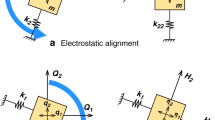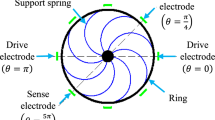Abstract
Gyroscopes operating along a single axis are widely developed and are currently batch-fabricated. Several applications which require three-dimensional (3D) motion have necessitated the need for a detailed study of a 3D vibratory gyroscope. We consider a functionally graded plate gyroscope (FGPG) with an arbitrary number of sections supported by means of a rigid stem at the center. The system vibrates both in- and out-of-plane. We derive the equations of motion for the system and show that a slow 3D inertial rotation rate of the gyroscope can be calculated approximately in terms of amplitudes of vibration. These amplitudes should be experimentally determinable. The in- and out-of-plane vibrations are excited respectively with different circumferential wave numbers. To realise a 3D vibrational gyroscope, the in- and out-of-plane eigenvalues are tuned by means of the variation of radial and/or axial lengths. To better understand the ordinary differential equations (ODE’s) modeling this system, we introduced an averaging operator. Numerical examples are included for two concentric components of the FGPG, where the inner component is made from an aluminum alloy and the outer component is made from a titanium alloy. Frequency spectra diagrams of tuned in- and out-of-plane vibrations are plotted. Diagrams of normalised eigenfunctions for both in- and out-of-plane vibrations are plotted.









Similar content being viewed by others
REFERENCES
N. C. Tsai and C.Y. Sue, “Experimental analysis and characterization of electrostatic-drive tri-axis micro-gyroscope,” Sens. Actuators A 158, 231–239 (2010). https://doi.org/10.1016/j.sna.2010.01.005
V. Ph. Zhuravlev and D. M. Klimov, A Wave Solid-State Gyroscope (Nauka, Moscow, 1985) [in Russian].
D. D. Lynch, “Vibratory gyro analysis by the method of averaging,” in Proc. 2 nd St. Petersburg International Conf. on Integrated Navigation Systems (ICINS’1995) (1995, St. Petersburg), Part. II, pp. 18–26.
E. J. Loper and D. D. Lynch, “The HRG: A new low-noise inertial rotation sensor,” in Proc. of the 16 th Jt. Services Data Exchange for Inertial Systems (Los Angeles, 1982), pp. 16–18.
V. Ph. Zhuravlev and D. D. Lynch, “Electric model of a hemispherical resonator gyroscope,” Mech. Solids 30 (5), 10–21 (1995).
Yu. K. Zhbanov, “Self-tuning contour of quadrature suppression in a hemispherical resonator gyroscope,” Giroskop. Navig. 2, 37–42 (2007).
J. S. Burdess and T. Wren, “The theory of a piezoelectric-disc gyroscope,” IEEE. Trans. Aerosp. Eng. Sys. 22 (4), 110–118 (1986). https://doi.org/10.1109/TAES.1986.310776
G. T. Sedebo, S. V. Joubert, and M. Y. Shatalov, “An analytical theory for a three-dimensional thick-disc, thin-plate vibratory gyroscope,” J. Phys.: Conf. Series 991, 012072 (2018). https://doi.org/10.1088/1742-6596/991/1/012072
G. T. Sedebo, “The Dynamics of a Tuning Disc Vibratory Gyroscope,” DTech Thesis (Tshwane Univ. Tech., Pretoria, 2019).
B. J. Gallacher, J. A. Neasham, J. S. Burdess, and A. J. Harris, “Initial test results from a 3-axis vibrating ring gyroscope,” J. Phys.: Conf. Ser. 34, 662–667 (2006). https://doi.org/10.1088/1742-6596/34/1/109
B. J. Gallacher, J. S. Burdess, and A. J. Harris, “Principles of a three-axis vibrating gyroscope,” IEEE. Trans. Aerosp. Elec. Sys. 37 (4), 133–1343 (2001). https://doi.org/10.1109/7.976969
G. T. Sedebo, M. Y. Shatalov, and S. V. Joubert, “Non-axisymmetric vibration of tuned thin functionally graded planar structures,” in Solid Mechanics, Theory of Elasticity and Creep, Ed. by H. Altenbach, S. M. Mkhitaryan, V. Hakobyan, (Springer Nature, Cham, 2022) (in press). https://link.springer.com/book/9783031185632
S. V. Joubert, M. Y. Shatalov, and T. H. Fay, “On numerically solving an eigenvalue problem arising in a resonator gyroscope,” Appl. Math. Comp. 246, 561–571 (2014). https://doi.org/10.1016/j.amc.2014.08.056
V. V. Novozhilov, The Theory of Thin Shells (Walters Noordhoff, Groningen, 1970).
A.L. Goldenveizer, Theory of Elastic Thin Shells (Pergamon Press, Oxford, 1961).
V. Ph. Zhuravlev and D. M. Klimov, Applied Methods in Oscillation Theory (Nauka, Moscow, 1988) [in Russian].
ACKNOWLEDGMENTS
This material is based upon work supported financially by the Tshwane University of Technology (TUT). Any opinions, findings and conclusions or recommendations expressed in this material are those of the authors, and TUT therefore does not accept any liability in regard thereto.
Funding
The work was financially supported by the Tshwane University of Technology.
Author information
Authors and Affiliations
Corresponding authors
About this article
Cite this article
Sedebo, G., Shatalov, M.Y., Joubert, S.V. et al. The Dynamics of a Three-Dimensional Tuning Functionally Graded Plate Gyroscope. Mech. Solids 57, 1577–1589 (2022). https://doi.org/10.3103/S0025654422060267
Received:
Revised:
Accepted:
Published:
Issue Date:
DOI: https://doi.org/10.3103/S0025654422060267




